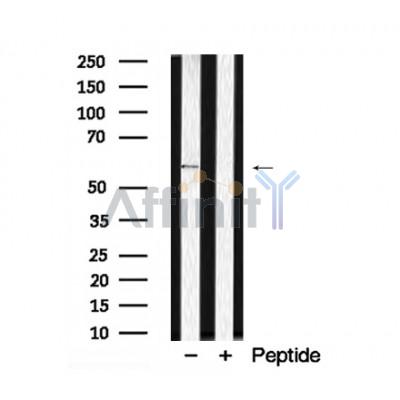GRK1 Antibody - #AF7899
| Product: | GRK1 Antibody |
| Catalog: | AF7899 |
| Description: | Rabbit polyclonal antibody to GRK1 |
| Application: | WB |
| Reactivity: | Human, Mouse, Rat, Monkey |
| Prediction: | Pig, Bovine, Horse, Rabbit, Dog, Xenopus |
| Mol.Wt.: | 60kDa; 64kD(Calculated). |
| Uniprot: | Q15835 |
| RRID: | AB_2844263 |
Related Downloads
Protocols
Product Info
*The optimal dilutions should be determined by the end user. For optimal experimental results, antibody reuse is not recommended.
*Tips:
WB: For western blot detection of denatured protein samples. IHC: For immunohistochemical detection of paraffin sections (IHC-p) or frozen sections (IHC-f) of tissue samples. IF/ICC: For immunofluorescence detection of cell samples. ELISA(peptide): For ELISA detection of antigenic peptide.
Cite Format: Affinity Biosciences Cat# AF7899, RRID:AB_2844263.
Fold/Unfold
EC=2.7.11.14; G protein-coupled receptor kinase 1; GPRK1; Grk1; Rhodopsin kinase; RHOK; RK; RK_HUMAN;
Immunogens
A synthesized peptide derived from human GRK1, corresponding to a region within N-terminal amino acids.
- Q15835 GRK1_HUMAN:
- Protein BLAST With
- NCBI/
- ExPASy/
- Uniprot
MDFGSLETVVANSAFIAARGSFDGSSSQPSRDKKYLAKLKLPPLSKCESLRDSLSLEFESVCLEQPIGKKLFQQFLQSAEKHLPALELWKDIEDYDTADNDLQPQKAQTILAQYLDPQAKLFCSFLDEGIVAKFKEGPVEIQDGLFQPLLQATLAHLGQAPFQEYLGSLYFLRFLQWKWLEAQPMGEDWFLDFRVLGKGGFGEVSACQMKATGKLYACKKLNKKRLKKRKGYQGAMVEKKILMKVHSRFIVSLAYAFETKADLCLVMTIMNGGDIRYHIYNVNEENPGFPEPRALFYTAQIICGLEHLHQRRIVYRDLKPENVLLDNDGNVRISDLGLAVELLDGQSKTKGYAGTPGFMAPELLQGEEYDFSVDYFALGVTLYEMIAARGPFRARGEKVENKELKHRIISEPVKYPDKFSQASKDFCEALLEKDPEKRLGFRDETCDKLRAHPLFKDLNWRQLEAGMLMPPFIPDSKTVYAKDIQDVGAFSTVKGVAFDKTDTEFFQEFATGNCPIPWQEEMIETGIFGELNVWRSDGQMPDDMKGISGGSSSSSKSGMCLVS
Predictions
Score>80(red) has high confidence and is suggested to be used for WB detection. *The prediction model is mainly based on the alignment of immunogen sequences, the results are for reference only, not as the basis of quality assurance.
High(score>80) Medium(80>score>50) Low(score<50) No confidence
Research Backgrounds
Retina-specific kinase involved in the signal turnoff via phosphorylation of rhodopsin (RHO), the G protein- coupled receptor that initiates the phototransduction cascade. This rapid desensitization is essential for scotopic vision and permits rapid adaptation to changes in illumination (By similarity). May play a role in the maintenance of the outer nuclear layer in the retina (By similarity).
Autophosphorylated, Ser-21 is a minor site of autophosphorylation compared to Ser-491 and Thr-492 (By similarity). Phosphorylation at Ser-21 is regulated by light and activated by cAMP.
Farnesylation is required for full activity.
Membrane>Lipid-anchor. Cell projection>Cilium>Photoreceptor outer segment.
Note: Subcellular location is not affected by light or dark conditions.
Retinal-specific. Expressed in rods and cones cells.
Belongs to the protein kinase superfamily. AGC Ser/Thr protein kinase family. GPRK subfamily.
Research Fields
· Cellular Processes > Transport and catabolism > Endocytosis. (View pathway)
· Organismal Systems > Immune system > Chemokine signaling pathway. (View pathway)
· Organismal Systems > Sensory system > Phototransduction.
Restrictive clause
Affinity Biosciences tests all products strictly. Citations are provided as a resource for additional applications that have not been validated by Affinity Biosciences. Please choose the appropriate format for each application and consult Materials and Methods sections for additional details about the use of any product in these publications.
For Research Use Only.
Not for use in diagnostic or therapeutic procedures. Not for resale. Not for distribution without written consent. Affinity Biosciences will not be held responsible for patent infringement or other violations that may occur with the use of our products. Affinity Biosciences, Affinity Biosciences Logo and all other trademarks are the property of Affinity Biosciences LTD.
